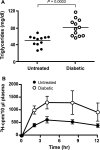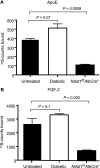Insulin-dependent diabetes mellitus in mice does not alter liver heparan sulfate
- PMID: 20236939
- PMCID: PMC2863227
- DOI: 10.1074/jbc.M110.112391
Insulin-dependent diabetes mellitus in mice does not alter liver heparan sulfate
Abstract
Diabetes -associated hyperlipidemia is generally attributed to reduced clearance of plasma lipoproteins, especially remnant lipoproteins enriched in cholesterol and triglycerides. Hepatic clearance of remnants occurs via low density lipoprotein receptors and the heparan sulfate proteoglycan, syndecan-1. Previous studies have suggested alterations in heparan sulfate proteoglycan metabolism in rat and mouse diabetic models, consistent with the idea that diabetic dyslipidemia might be caused by alterations in proteoglycan expression in the liver. In this study we analyzed the content and composition of liver heparan sulfate in streptozotocin-induced insulin-deficient diabetic mice that displayed fasting hypertriglyceridemia and delayed clearance of dietary triglyceride-rich lipoproteins. No differences between normal and diabetic littermates in liver heparan sulfate content, sulfation, syndecan-1 protein levels, or affinity for heparin-binding ligands, such as apolipoprotein E or fibroblast growth factor-2, were noted. Decreased incorporation of [(35)S]sulfate in insulin-deficient mice in vivo was observed, but the decrease was due to increased plasma inorganic sulfate, which reduced the efficiency of labeling of liver heparan sulfate. These results show that hyperlipidemia in insulin-deficient mice is not due to changes in hepatic heparan sulfate composition.
Figures




References
-
- Haffner S. M. (1998) Endocr. Rev. 19, 583–592 - PubMed
-
- Goldberg R. B. (2003) Cardiol. Clin. 21, 399–413 - PubMed
-
- Bar-On H., Roheim P. S., Eder H. A. (1976) Diabetes 25, 509–515 - PubMed
-
- Ebara T., Hirano T., Mamo J. C., Sakamaki R., Furukawa S., Nagano S., Takahashi T. (1994) Metabolism 43, 299–305 - PubMed
Publication types
MeSH terms
Substances
Grants and funding
LinkOut - more resources
Full Text Sources
Medical

